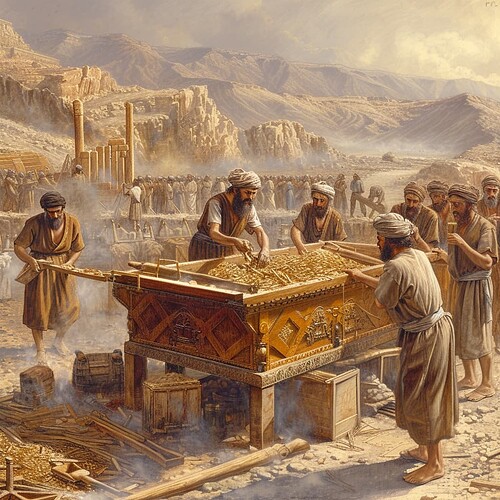 February 24: Exodus 37 - Crafting the Sacred and Testimony of God’s Presence
February 24: Exodus 37 - Crafting the Sacred and Testimony of God’s Presence
 Introduction
Introduction
In Exodus 37, we find Bezalel, an artisan endowed with God-given talent and wisdom, meticulously crafting the Ark, the Table, the Lampstand, and the Altar of Incense: Each piece bearing immense communal and spiritual significance for the Israelites.
 Creating the Ark and its Furnishings
Creating the Ark and its Furnishings
Bezalel and team fulfill God’s detailed instructions: The Ark of the Covenant, symbolizing God’s presence and the Table for the Bread of Presence, a constant reminder that God sustains His people.
Key Verse: Exodus 37:1 “Bezalel made the ark of acacia wood—two and a half cubits long, a cubit and a half wide, and a cubit and a half high.”
 Crafting the Golden Lampstand
Crafting the Golden Lampstand
The careful crafting of the lampstand, symbolizing God’s light guiding His people, reminds us that God’s directions are invaluable, empowering us to traverse spiritual darkness.
Key Verse: Exodus 37:17 “He also made the lampstand of pure gold…”
 Key Themes and Reflections
Key Themes and Reflections
1. God-inspired Craftsmanship: Exodus 37 emphasizes the beauty and nobility of craftsmanship inspired and directed by God. Each piece crafted demonstrates the hard work, talent, and dedication we can offer back to God when we use our unique gifts for His glory.
2. Presence and Provision: The artifacts symbolize God’s sustaining presence within the Israelite community and remind us today that God is ever-present in our lives, guiding and providing in ways we often don’t recognize.
 Today’s Application
Today’s Application
Exodus 37 encourages us to use our God-given talents in service of others, realizing we are part of a larger community united under God’s love and shelter.
 Hidden Gem
Hidden Gem
The Ark, Lampstand, Table, and Altar are laden with symbolism, directly tied to Jesus Christ in the New Testament - The Ark (Jesus, God among us), Lampstand (Jesus, the Light of the World), Table (Jesus, Bread of Life), and Altar (Jesus, our High Priest).
 Reflective Q&A
Reflective Q&A
![]() How does Exodus 37 encourage us to use our specific gifts?
How does Exodus 37 encourage us to use our specific gifts?
A: Exodus 37 implicitly teaches us to use our unique talents for God’s glory and people’s service.
![]() What does the crafting of these items reveal about God’s nature?
What does the crafting of these items reveal about God’s nature?
A: It reveals God as meticulous, indicative of His profound love - God cares about even minute details of our lives.
 Join the Discussion
Join the Discussion
Share your thoughts on today’s reading. How do you use your talents to serve God & others?
 See You Tomorrow in Exodus 38
See You Tomorrow in Exodus 38
Tomorrow, we’ll delve into the crafting of the altar of burnt offering and basin for washing; another testament to God’s careful planning in worship.
